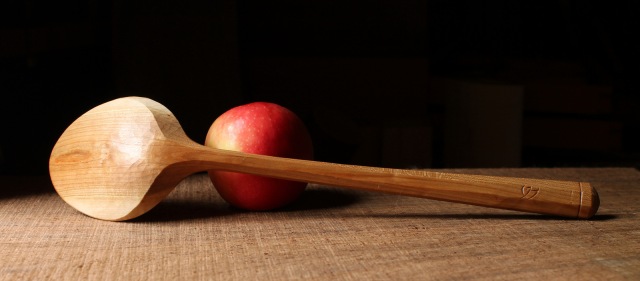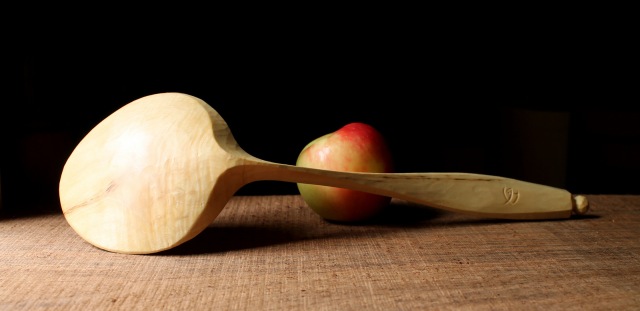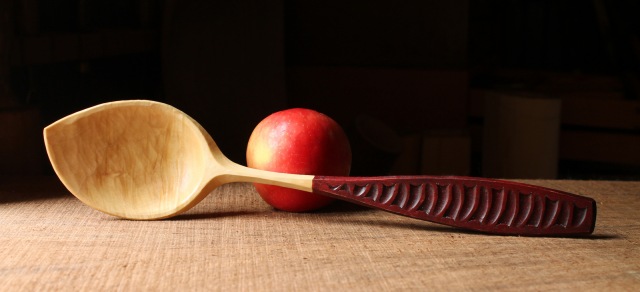
I’ve finished five big spoons from big crooks, three in black cherry, two in hard (sugar) maple. I’ll post them here below. They’re all straight from the knife and treated with flaxseed (linseed) oil. I had fun experimenting with some different designs on these. They’re all serving/cooking spoons, way too big for eating spoons. I’ll mention each spoon’s unique characteristics with the photos below. Rather than listing them separately on my website, I’ll offer them right here in the blog post. If you’d like to purchase one, send me an email at dandkfish@gmail.com. All prices include shipping in the U.S. Orders outside of the U.S. will require an additional shipping charge, but it’s not usually too high for spoons. I’ll get back to you to confirm, and you can pay by mailing a check or through paypal.
Spoon #1 (below): Black Cherry, 13″ x 3″. This spoon would be great for general use — cooking, stirring, serving. The facets of the octagonal handle each flow onto and around the bowl of the spoon. $135 includes shipping. SOLD




Spoon #2 (below): Sugar Maple, 14″ x 4″. This spoon came from a large sugar maple crook that was a bear to carve, but will make an incredibly long-lasting serving spoon. With a bowl that is 4″ x 5″, your grandchildren will still be serving their grandchildren mountains of mashed potatoes! I cut across the handle with my hook knife to create the irregular pattern, and finished with a ball finial. $165 includes shipping. SOLD



Spoon #3 (below): Black Cherry, 12 1/4″ x 2 1/4″. This cherry cooking/stirring spoon will reach deep into the pot. The heartwood runs along the back side of the octagonal handle and up through the center of the bowl. $85 includes shipping. SOLD


Spoon #4 (below): Sugar Maple, 12 3/4″ x 2 7/8″. Carved from the upper portion of the same crook as the maple spoon above, this is a hardy cooking and stirring spoon with lovely figure through the bowl. After carving the handle pattern with cuts from a gouge, I painted it with thinned artist-oil paint that allows the grain to read through. With a little use, the paint will naturally begin to rub off on the edges and raised areas creating a beautiful patina of use. $130 includes shipping. SOLD



Spoon #5 (below): Black Cherry, 13 1/2″ x 3 1/4″. I just love this big spoon from a crook that was curved in both directions. The fibers flow unbroken through the handle and up through the bottom of the bowl. Very comfortable to use as a serving spoon — for righties anyway. Again, I carved across the handle with my hook knife, but more regularly in this case. That little sap pocket in the bowl of the spoon actually has a little opening that passes through, but you won’t lose much food! $180 includes shipping. SOLD





beauties
LikeLiked by 1 person
Aaaand … they’re sold. 🙂
And no wonder; they’re beautiful, as always. I would *love* to see a video of you carving a spoon, but apparently none exist. Any chance you’ll do one?
LikeLiked by 1 person
Hmmm. I guess you’re right, Karl; I don’t think I’ve been recorded while carving a spoon. I’ll try to do that sometime.
Thanks for your kind words about the spoons.
LikeLiked by 2 people
I would second with the request to see a instruction video of you carving a spoon!!! You do such beautiful work!!!!
LikeLike
Amazing work.
LikeLiked by 1 person
Pure beauty, brute but refined. Esthétique, warmth… Time stand still-objects.
Thank you.
LikeLiked by 1 person
As always, beautiful work David, and great work with the camera!
LikeLike
Thanks, John. Had some nice light coming through the window.
LikeLike
Hey Dave, one question about spoon design: where can a novice spoon carver get templates (top view and profile) for spoons?
This is an area of struggle for me. I have several books and see finished pieces on the web but I can’t visualize the spoon through the entire process. I have videos and books describing cuts and techniques but no one says, here is a shape, cut it out on some cardboard and use it to redraw your pencil lines. Therefore, I get my spoons into a general spoon-ish shape and then struggle to keep the good bits and remove the bad.
I’m not asking to be spoon fed (pun intended) but just like using magazine drawings for my furniture as guidelines, it seems like there is a gap in the spoon world. Maybe I’ve just missed it??
Anyway, I greatly admire your work and thought you might know of a good source.
Thanks,
Shawn
LikeLike
I think there are some sort of spoon templates available, Shawn. I think I may have even seen some sort of thing in the Greenwood Shop at the Fest. I know nothing about them or where to get them. Maybe some other reader will offer some information.
I’ve never used templates for bowls or spoons. Not doing so allows me to vary dimensions and shapes according to what the particular piece of tree has to offer. The sculptural aspect of spoons and the nature of carving them with axe and knife would seem to me to limit the effectiveness of templates. I can see a template being useful for the top shape in some ways, but I have a tough time imagining transferring it for a side profile, at least not without dramatically altering the way I go about the carving.
That said, I think there are some effective ways to help guide your eye and/or achieve some consistency if that’s what you’re after. Establish a center line on the top of your blank, straight or curved. After that I just sketch on the outline of the spoon, and that line is a great reference. If you want a little more guidance, try using a compass to help your eyes. For example, to draw an egg-shaped spoon bowl, strike a large circle to represent the back end of the bowl, then, sliding the point of the compass forward on the center line, strike a smaller circle representing the front curve. Sketch a couple curves connecting the two circles to complete the shape. This is similar to how I use a compass to guide the lay out of many (non-spoon) bowls, and unlike a particular template, it is completely adjustable to various size or proportions.
After awhile, on the small scale of spoons you might find that your eye and hand have become so practiced in drawing (and carving) fair curves that you may not bother with the compass. Find curves in nature and practice sketching them. No need to draw the whole object unless you want to. It’s just an exercise.
LikeLike
Thanks Dave. These are good points. I appreciate you taking the time for such a thorough response. I’m not looking for an exact step by step but just better guidelines. If any other readers have ideas I’d love to hear them.
LikeLike
After re-reading your original question, I think I see more clearly what you’re after, Shawn. By following an orderly logical sequence when carving spoons it is possible to not have to redraw lines much and end up with a clear vision of what to keep and remove after the rough-out.
If you don’t have it, I’d recommend picking up a copy of “Carving and Whittling: The Swedish Style” by Gert Ljungberg and Inger A:son-Ljungberg. It includes a few pages of sketches of suggested spoon shapes, both from above and the side profile. Great book overall as well. And you probably already have Swedish Carving Techniques by Wille Sundqvist. If not, that is a must have. Barn the Spoon’s new book goes through several spoon designs in a procedural way.
LikeLike
Darn, missed this sale. I will have a Fisher spoon in my house one of these days. Beautiful work David. What a variety of shapes, lines, and purpose.
LikeLike